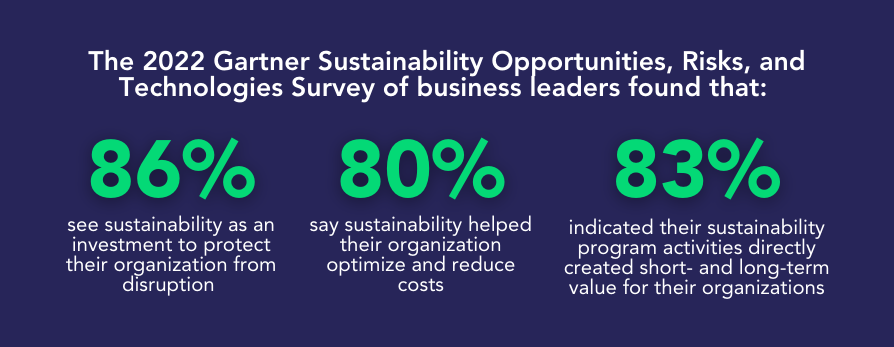Our virtual world creates a substantial impact on our physical environment. The reliance on digital devices, the exponential growth of Big Data, and the advent of powerful technologies that enable numerous connected AI and IoT applications are energy-intensive.
Computers, data centers, and networks consume 10% of the world's electricity—30% of which powers terminal equipment (e.g., computers, mobiles, and other devices), 30% runs data centers, and 40% goes to network infrastructures.
Organizations are racing to reduce their IT carbon footprint—not only to meet their environmental, social, and governance (ESG) goals. These strategies can also help them lower IT operating costs and increase efficiency.

[ Source: Gartner ]
A cost-effective way to lower the energy cost of running your IT infrastructure is cloud computing. Let’s look at how it helps reduce energy consumption and how to overcome one of the top challenges of advancing sustainability in IT.
How Cloud Computing Reduces Energy Consumption
Cloud computing is 93% more energy-efficient than on-premises data centers, according to Microsoft and WSP Global Inc. Meanwhile, Amazon found that cloud computing uses 77% fewer servers and 84% less power.
Cloud providers achieve energy savings by maximizing resource utilization, building energy-efficient data centers, and optimizing their infrastructure. Here’s how cloud data centers contribute to a smaller carbon footprint:
-
Server virtualization consolidates workloads, allowing data centers to operate more efficiently by reducing the number of servers required.
-
Data centers leverage advanced cooling technologies, energy-efficient hardware, and optimized layouts to minimize energy use without compromising performance.
-
A multi-tenancy architecture houses several customers on the same physical infrastructure to achieve economies of scale and higher energy efficiency.
-
Green energy sourcing strategy uses power from renewable sources (e.g., on-site wind and solar) to reduce a data center’s carbon footprint.
-
Geographic optimization locates data centers in regions with favorable climate conditions for cooling and/or areas with local renewable energy sources.
-
Advanced energy management software optimizes data center operations, including power distribution, cooling, and load balancing to reduce energy consumption.
-
Energy-efficient hardware, such as low-power processors and memory, reduces the energy consumption of servers and storage systems.
However, using a cloud data center is just the first step. Most organizations aren’t maximizing their investments because they fail to optimize every component in their infrastructure to reduce energy consumption.
Overcoming a Top Challenge in Achieving IT Sustainability
Organizations waste as much as 35% of their cloud spend on resources they never use. As a result, some companies underestimate the financial benefits of using cloud resources — making them less likely to increase their cloud investment for more sustainable IT operations.
The first step to fully leveraging the cost-savings and environmental benefits of cloud computing is to track KPIs that focus on maximizing infrastructure utilization. The insights will help you right-size your underlying equipment and implement appropriate governance processes to prevent IT sprawl that increases energy consumption.
So, how do you track these KPIs and generate meaningful insights? Use a dashboard designed to collect and analyze actual utilization-level information to identify improvement opportunities in your hybrid cloud deployment.
Then, implement business processes to support ongoing compliance and cost controls to ensure your infrastructure meets governance requirements, including power consumption and energy sourcing. Meanwhile, continuous cost monitoring enables you to uncover deviation from your projection to identify resource sprawl and inefficiencies.
HPE GreenLake Introduces a New Sustainability Dashboard
HPE recently announced the launch of a new sustainability dashboard for the HPE GreenLake edge-to-cloud platform. It provides enterprises with a comprehensive approach, transforming their sustainability initiatives from incremental pockets of activities to a holistic strategy spanning every IT domain.
The dashboard delivers critical insights on IT energy consumption, carbon emissions, and electricity costs to help monitor, observe, and reduce power usage across your IT real estate. It leverages advanced analytics from the HPE portfolio to help you improve overall sustainability performance. You can also manage multi-vendor infrastructure and application resources in hybrid and multi-cloud IT environments.
At Compugen, we partner with HPE to help our customers leverage the leading technology vendor’s vast portfolio of products and services to support their digital transformation journey.
As your technology ally, we’ll assess your requirements and implement HPE GreenLake to accelerate data-first modernization with the edge-to-cloud platform—bringing the cloud to you while advancing your sustainability goals. We stay with you every step, from design and implementation to ongoing improvement and optimization, turning insights into action.
Schedule an HPE GreenLake assessment to see how we can help you reach your business and sustainability goals.






.png)